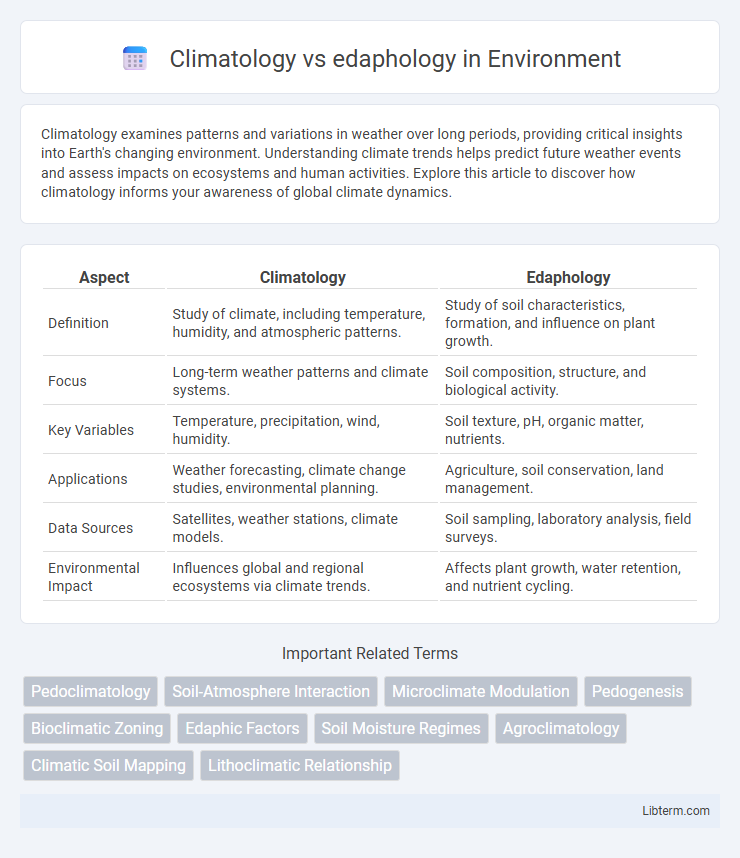Climatology examines patterns and variations in weather over long periods, providing critical insights into Earth's changing environment. Understanding climate trends helps predict future weather events and assess impacts on ecosystems and human activities. Explore this article to discover how climatology informs your awareness of global climate dynamics.
Table of Comparison
| Aspect | Climatology | Edaphology |
|---|---|---|
| Definition | Study of climate, including temperature, humidity, and atmospheric patterns. | Study of soil characteristics, formation, and influence on plant growth. |
| Focus | Long-term weather patterns and climate systems. | Soil composition, structure, and biological activity. |
| Key Variables | Temperature, precipitation, wind, humidity. | Soil texture, pH, organic matter, nutrients. |
| Applications | Weather forecasting, climate change studies, environmental planning. | Agriculture, soil conservation, land management. |
| Data Sources | Satellites, weather stations, climate models. | Soil sampling, laboratory analysis, field surveys. |
| Environmental Impact | Influences global and regional ecosystems via climate trends. | Affects plant growth, water retention, and nutrient cycling. |
Introduction to Climatology and Edaphology
Climatology studies atmospheric patterns and climate systems over time, analyzing temperature, humidity, and precipitation to understand weather trends and climate change. Edaphology focuses on soil properties, formation, and classification, emphasizing soil's influence on plant growth and ecosystem health. Both disciplines intersect by assessing how climate impacts soil processes and, in turn, affects terrestrial environments.
Defining Climatology: Scope and Importance
Climatology studies long-term atmospheric patterns, analyzing temperature, precipitation, humidity, and wind trends to understand climate systems and their impact on ecosystems. This field is crucial for predicting weather changes, assessing global warming effects, and informing agricultural planning and disaster management. Edaphology, in contrast, focuses on soil properties and their influence on plant growth, linking soil science with environmental and climatic factors.
Edaphology Explained: Focus and Significance
Edaphology is the scientific study of soil in relation to soil-dependent uses, emphasizing soil formation, classification, and mapping to understand its influence on plant growth and ecosystem health. It focuses on the physical and chemical properties of soil, including nutrient content, moisture retention, and microbial activity, critical for agriculture, forestry, and environmental management. Unlike climatology, which analyzes atmospheric conditions and climate patterns, edaphology directly addresses soil characteristics essential for sustainable land use and crop productivity.
Key Differences Between Climatology and Edaphology
Climatology studies the long-term patterns and effects of atmospheric conditions including temperature, humidity, and precipitation, whereas edaphology focuses specifically on soil properties, formation, and its influence on plant growth. Climatology uses data from meteorological stations and satellites to analyze climate dynamics, while edaphology involves field sampling and laboratory analysis of soil texture, structure, and nutrients. The key difference lies in climatology addressing atmospheric phenomena on a regional or global scale, compared to edaphology's detailed soil-centric ecological and agricultural investigations.
Interactions Between Climate and Soil
Climatology studies atmospheric conditions and their long-term patterns, while edaphology focuses on soil properties and processes; their interaction is crucial for understanding soil formation and nutrient cycling. Climate influences soil moisture, temperature, and organic matter decomposition, shaping soil fertility and structure. Conversely, soil characteristics affect local microclimates through water retention and heat exchange, highlighting a dynamic feedback loop between climate and soil systems.
Methodologies in Climatology vs Edaphology
Climatology employs remote sensing, climate modeling, and atmospheric data analysis to study weather patterns and long-term climate changes. Edaphology uses soil sampling, chemical analysis, and field experiments to investigate soil properties and their effects on plant growth. Both disciplines rely on advanced statistical tools but apply distinct methodologies tailored to their environmental focus.
Applications in Agriculture and Environmental Science
Climatology examines climate patterns and atmospheric conditions to predict weather impacts on crop growth, soil moisture, and pest dynamics, aiding in sustainable agricultural planning. Edaphology focuses on soil properties, composition, and health, directly influencing nutrient management, soil fertility, and crop yield optimization. Together, these disciplines enhance environmental science by promoting resilient agroecosystems and informed land-use decisions.
Impact on Ecosystems and Biodiversity
Climatology studies the long-term atmospheric patterns that influence temperature, precipitation, and seasonal shifts, directly affecting ecosystem dynamics by altering habitat conditions and species distribution. Edaphology focuses on soil characteristics such as composition, moisture, and nutrient availability, which are critical for plant growth and soil microbial communities, thus shaping biodiversity at the ground level. Both disciplines are integral in understanding how climate-driven changes and soil health impact ecosystem resilience and species diversity over time.
Recent Research and Innovations
Recent research in climatology emphasizes advanced climate modeling and remote sensing technologies to better predict weather patterns and global warming effects. Innovations in edaphology focus on soil health monitoring using biotechnology and sensor networks to optimize agricultural productivity and carbon sequestration. Integration of climatological data with edaphological insights enables improved ecosystem management and sustainable land-use practices.
Future Trends in Climatology and Edaphology
Future trends in climatology emphasize advanced climate modeling, integrating AI and big data to improve predictions of extreme weather events and long-term climate change impacts. Edaphology is evolving with precision soil monitoring technologies, utilizing remote sensing and sensor networks to optimize soil health and sustainable land management practices. Both fields increasingly collaborate to address climate-soil interactions, crucial for enhancing agricultural resilience and ecosystem sustainability under changing environmental conditions.
Climatology Infographic

 libterm.com
libterm.com